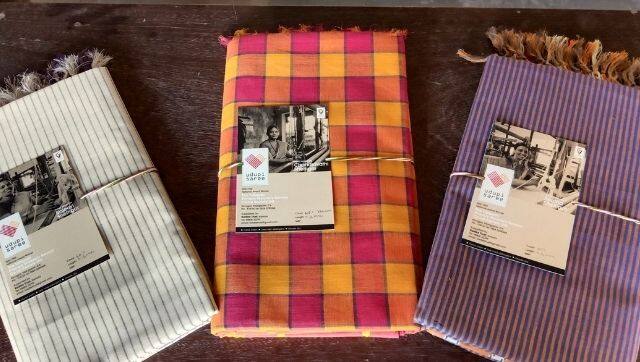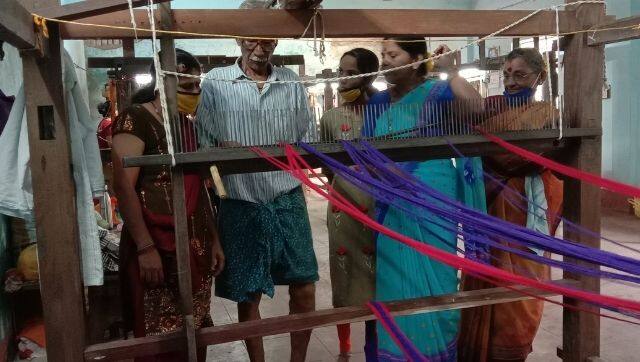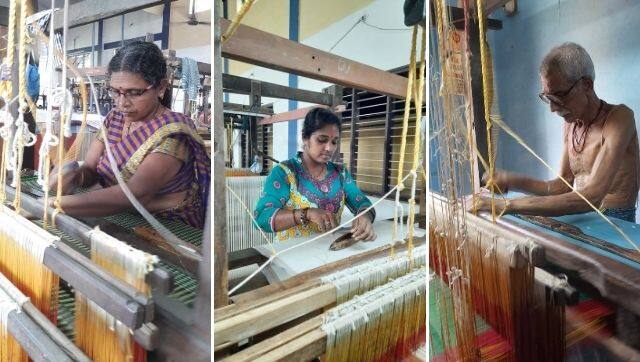“Weaving has boosted my physical and mental health; it is a way of life for me. I am not only mentally active but operating the looms strengthens my arms and legs,” says Vedavathi, 55, who returned to weaving after a long gap. Having been taken gravely ill, she had to give up weaving which she did for 20 years. But now with the support of the Kadike Trust, she is back where she belongs. Joining the trusts’ advance weaving workshop and working with several other women, Vedavathi has never been happier. In fact, Vedavathi has inspired her daughter Payaswini (28) to enrol for the training too. “I was really motivated seeing my mother and decided to take up weaving,” says Payaswini, who used to work as a social science and Kannada school teacher. She now plans to take up weaving full-time after the training. Organic growth of weavers This has been the story of many young women and a few men in the Dakshina Kannada and Udupi districts, who have been actively pursuing weaving as professionally. While some of them belong to the native “Shettigar” weavers’ community, others are from different communities and professions. “While Udupi saris are now seeing a major revival, it is heartening to note that in the recent past, we have seen an influx of youth getting initiated to weaving. This is the true essence of revival as we need the next generation to take up the profession so that the legacy can continue. Out of the 20 people who have joined our weaving and skill development training, 19 are women and come from varied professions like teaching, tailoring, pottery and even _beedi-_making,” says Mamtha Rai, president of the Kadike Trust. [caption id=“attachment_9287161” align=“alignnone” width=“640”]
 Udupi saris packaged[/caption] Kadike Trust is a non-profit organisation based in Udupi’s Karkala, and has been the cornerstone of the Udupi handloom sari revival project that started three years ago. The trust engineered by Rai, her husband BC Shetty, along with a few of their like-minded friends, took up the revival of these saris in association with the Talipady Weavers Society in Kinnigoli city in Karnataka, as their first project after witnessing the dire straits in which the industry was in a few years ago. “The handloom saris of Udupi is a legacy which has to be preserved not only for its heritage value, but for the fact that it is an industry that is not dependent on the consumption of fossil fuel. It is a handmade, sustainable and eco-friendly industry that has the propensity to provide employment to hundreds of people,” says Rai. Historical perspective The handloom industry in the Dakshina Kannada and Udupi districts was a flourishing one and dates back to the 18th century, when a number of migrants from the Padmashali (Shettigar) community of Andhra Pradesh and Kerala arrived in Karnataka. The industry gained further impetus with the introduction of frame looms by the Basel Mission in 1844, and the subsequent co-operative and cottage industry movement. There were close to 5,000 weaving families until the 1980s, and eight co-operative weaving societies in the region. All of them were represented by the Udupi co-operative society, and hence, the saris that were woven here were called the Udupi saris.
Udupi saris packaged[/caption] Kadike Trust is a non-profit organisation based in Udupi’s Karkala, and has been the cornerstone of the Udupi handloom sari revival project that started three years ago. The trust engineered by Rai, her husband BC Shetty, along with a few of their like-minded friends, took up the revival of these saris in association with the Talipady Weavers Society in Kinnigoli city in Karnataka, as their first project after witnessing the dire straits in which the industry was in a few years ago. “The handloom saris of Udupi is a legacy which has to be preserved not only for its heritage value, but for the fact that it is an industry that is not dependent on the consumption of fossil fuel. It is a handmade, sustainable and eco-friendly industry that has the propensity to provide employment to hundreds of people,” says Rai. Historical perspective The handloom industry in the Dakshina Kannada and Udupi districts was a flourishing one and dates back to the 18th century, when a number of migrants from the Padmashali (Shettigar) community of Andhra Pradesh and Kerala arrived in Karnataka. The industry gained further impetus with the introduction of frame looms by the Basel Mission in 1844, and the subsequent co-operative and cottage industry movement. There were close to 5,000 weaving families until the 1980s, and eight co-operative weaving societies in the region. All of them were represented by the Udupi co-operative society, and hence, the saris that were woven here were called the Udupi saris.
 Training in progress[/caption] The saris have also been used to adorn the deities of the Udupi Sri Krishna temple and the Shri Durga Parameshwari temple in Kateel in Dakshina Kannada. As a result of all this, the Talipady Society was able to pay a bonus to its weavers after 16 long years. The Kadike Trust has also been supporting the weavers of the Padupanambooru and Shivahalli Societies, and have also been felicitating weavers with incentives and awards on a regular basis. [caption id=“attachment_9287231” align=“alignnone” width=“640”]
Training in progress[/caption] The saris have also been used to adorn the deities of the Udupi Sri Krishna temple and the Shri Durga Parameshwari temple in Kateel in Dakshina Kannada. As a result of all this, the Talipady Society was able to pay a bonus to its weavers after 16 long years. The Kadike Trust has also been supporting the weavers of the Padupanambooru and Shivahalli Societies, and have also been felicitating weavers with incentives and awards on a regular basis. [caption id=“attachment_9287231” align=“alignnone” width=“640”]
 Udupi sari weavers at work[/caption] Holistic skill development training While the spike in demand is a positive sign, the challenge that remains is of ensuring a steady supply of saris, for which the number of skilled weavers have to increase. Kadike Trust has been providing a six-month-long intensive, holistic training for new as well as comeback weavers in association with NABARD. With two batches being trained, the number of weavers has risen to around 70, including 35 in Talipady alone. Today, there are weavers who are able to weave the butta saris as well the 80 count ones. “The training has really boosted our morale. Apart from weaving, we have one on one sessions where we can share our problems and concerns. This has built our confidence,” says Sadhana, 30, an electronics professional who was earlier working in Kochi.
Udupi sari weavers at work[/caption] Holistic skill development training While the spike in demand is a positive sign, the challenge that remains is of ensuring a steady supply of saris, for which the number of skilled weavers have to increase. Kadike Trust has been providing a six-month-long intensive, holistic training for new as well as comeback weavers in association with NABARD. With two batches being trained, the number of weavers has risen to around 70, including 35 in Talipady alone. Today, there are weavers who are able to weave the butta saris as well the 80 count ones. “The training has really boosted our morale. Apart from weaving, we have one on one sessions where we can share our problems and concerns. This has built our confidence,” says Sadhana, 30, an electronics professional who was earlier working in Kochi.
How the Udupi sari's revival in Karnataka has encouraged weavers to sustainably preserve its heritage
Rashmi Gopal Rao
• February 11, 2021, 09:00:01 IST
The first priority of the revival project was to establish a market for these saris so that they could be sold at higher prices, which would in turn compensate the weavers.
Advertisement
)
Post this period, the advent of the power looms caused the income of handloom weavers to plummet. Hence, the number of weavers diminished rapidly and most of them took up other jobs. Weaving was far from a respectable profession and the sari had lost its value among the locals too. When Rai started the project, the number of weavers across the five existing societies was just 42, with all of them being above the age of 50. Most of them were not working regularly and even when they did, they were being paid a pittance of Rs 50-55 per meter. The saris were selling at very low rates too. There were no weavers who could craft the signature 80 count and “butta” (motif) saris. Creating a market The first priority of the revival project was to establish a market for these saris so that they could be sold at higher prices, which would in turn compensate the weavers. Exhibitions and fairs were held to make people aware of the handloom saris, apart from marketing them actively on social media. An attractive logo and packaging was created that displayed the name and picture of the weaver on every sari. “These efforts paid off and now we have customers from all over India and abroad. The demand from locals has also picked up which again is an achievement,” says Rai, who also mentions that the saris are now priced from Rs 1,000-2,500. [caption id=“attachment_9287191” align=“alignnone” width=“640”]
Similar sentiments have been echoed by her friends Poornima (34) and Vidyavati (39), who are both tailors and have been enjoying the training. “Slowly and steadily, we are trying to build a strong ecosystem so that the young trainees who are the future of this industry stay motivated to pursue this profession and take pride in preserving their own heritage,” adds Rai. The Kadike Trust has also organised workshops on Azo-free dyeing and natural colour dyeing to make the saris eco-friendlier. They recently produced the Udupi sari with the ikkat design after 20 years. (Images courtesy Kadike Trust)
End of Article